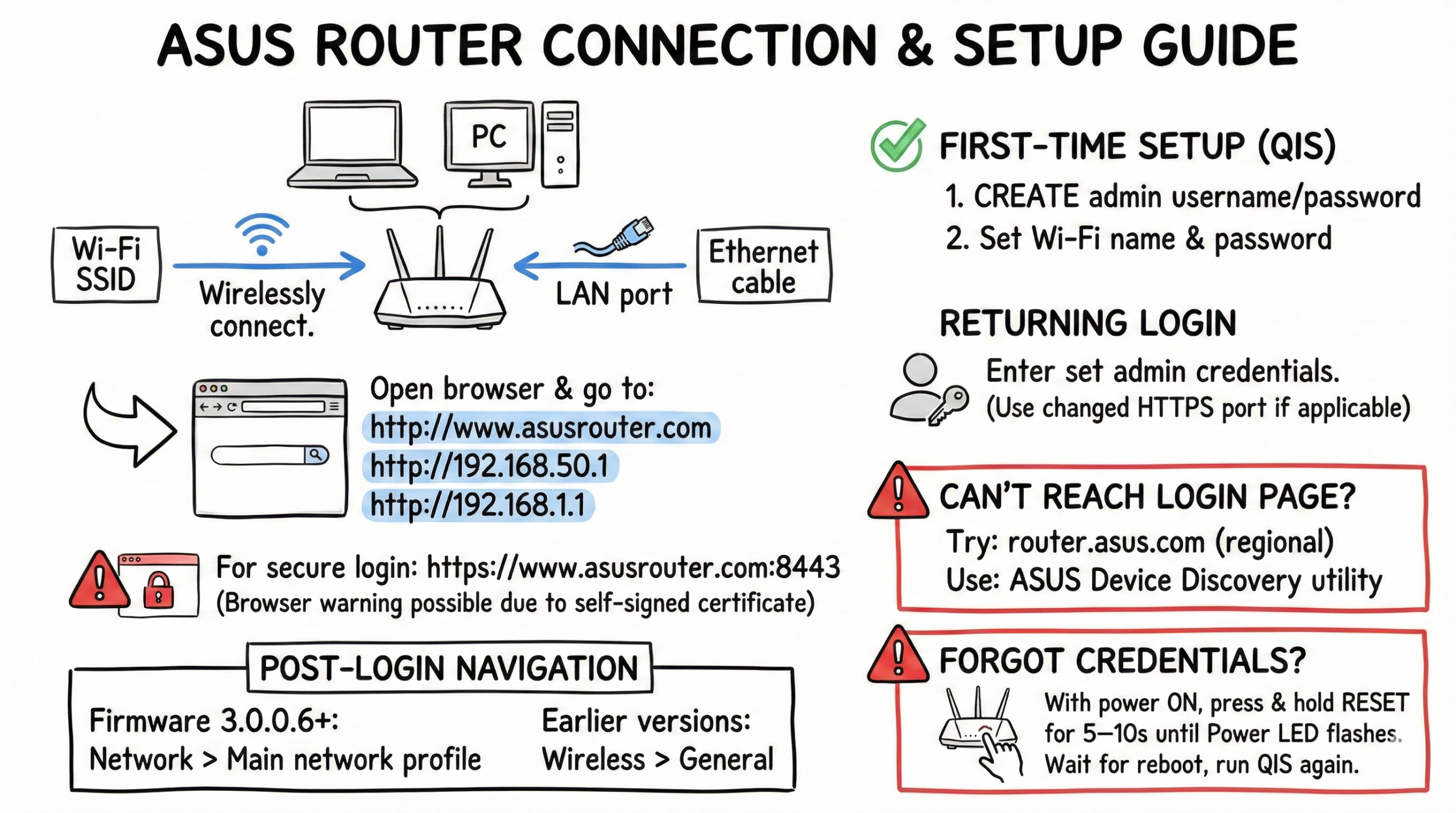Log in to your ASUS router to take control of your home network. By accessing your router’s settings, you can customize options that improve performance, security, and day-to-day reliability.
In this guide, we’ll show you exactly how to log in, fix common login problems, and highlight the most useful settings in ASUSWRT and the ASUS Router app.
Quick ASUS Router Login Guide
- Connect your laptop/PC to the router
- Wirelessly using your home Wi‑Fi SSID
- or connect an Ethernet cable to a LAN port on the router
- Open a web browser and go to one of the following
- http://www.asusrouter.com (primary)
- http://192.168.50.1 or http://192.168.1.1 (model dependent)
- For secure login: https://www.asusrouter.com:8443 (you may see a browser warning due to the router’s self‑signed certificate)
- First‑time setup (QIS)
- You’ll be prompted to create the router’s admin username/password (no universal default).
- Set your Wi‑Fi name and password during QIS.
- Returning login
- Enter the admin credentials you set. If you changed the HTTPS port, use that port instead of 8443.
- Post‑login
- On firmware 3.0.0.6+, Wi‑Fi options are under Network > Main network profile. On earlier versions, go to Wireless > General.
- Can’t reach the login page?
- Try router.asus.com (regional) or use the ASUS Device Discovery utility to find the router’s current LAN IP.
- Forgot credentials?
- With power on, press and hold Reset for 5–10 seconds until the Power LED flashes. Wait for the reboot and run QIS again.
If you’re already in, great. If not, keep going—these steps cover what most people miss.
Gathering Required Information
Before you begin, have the following ready:
- ASUS router address: Many models respond at http://www.asusrouter.com. You can also try http://192.168.50.1 or http://192.168.1.1, and in some regions https://router.asus.com. Use https://www.asusrouter.com:8443 for HTTPS.
- Admin credentials: On first login or after a factory reset, most ASUSWRT versions prompt you to create the admin username and password during Quick Internet Setup (QIS). Some models include a device‑specific default on the label—check your unit if present.
You can usually find your model’s defaults on the router label or in the user manual.
Connecting to Your ASUS Router
There are two main ways to connect:
- Wired connection: Use an Ethernet cable to connect your computer directly to one of the router’s LAN ports.
- Wireless connection: Connect to your router’s default wireless network (SSID), which may appear as ASUS_XX, ASUS_XX_5G, or on Wi‑Fi 6E/7 models ASUS_XX_6G. If Smart Connect is enabled, bands may share a single SSID.
If you’re experiencing connection issues, try these steps:
- Ensure your router is powered on and the LED lights are stable.
- Check that your Ethernet cable is securely connected or that you’re on the correct wireless network.
- Restart your router and your connected device.
Accessing the Router Login Page
Once connected, follow these steps to access the login page:
- Open a web browser on your device. Chrome, Firefox, Safari, and Edge are all compatible.
- In the address bar, enter http://www.asusrouter.com or your router’s IP such as http://192.168.50.1 or http://192.168.1.1, then press Enter.
- For a secure session, use https://www.asusrouter.com:8443. Because the router uses a self‑signed certificate, your browser may show a warning—this is expected on local networks. Proceed to continue.
- If the page doesn’t load: double‑check the address, try a private window, or switch browsers. You can also try router.asus.com or use the ASUS Device Discovery utility to find the current LAN IP.
Entering Login Credentials
On the ASUS router login page, enter your admin username and password carefully—fields are case‑sensitive.
- First‑time login or after reset: You will be guided by Quick Internet Setup (QIS) to create the admin credentials. There is no universal admin/admin default on most current firmware.
- Device label: Some models print temporary defaults on the label. If present, use those to start QIS and then set your own credentials.
If you’ve forgotten your custom login, reset the router to factory settings by holding Reset for 5–10 seconds until the Power LED flashes, then wait for the reboot and run QIS again.
Navigating the ASUS Router Web Interface (ASUSWRT)
After login, you’ll see the ASUS Router Web Interface (ASUSWRT). Use it to configure your network. The main settings include:
- Network Map: Displays connected devices and their status.
- Guest Network: Set up a separate network for visitors.
- AiProtection: Security features like malicious site blocking and parental controls; some app‑only tools include ASUS Safe Browsing.
- Adaptive QoS: Prioritizes network traffic for optimal performance.
- Traffic Analyzer: Monitors network usage by device.
- USB Application: Manages USB storage and printer sharing.
- AiMesh: Sets up a mesh network with multiple ASUS routers.
- Wireless: Configures Wi‑Fi settings. On firmware 3.0.0.6.102_35404 and later, Wi‑Fi name/password are under Network > Main network profile; earlier versions use Wireless > General.
- WAN: Internet connection settings.
- LAN: Local network settings, including DHCP and routing.
- VPN: Supports traditional VPN types and many models now support WireGuard VPN.
- Firewall: Advanced security settings.
- Administration: System settings, firmware updates, and backup/restore.
Explore these pages and click Apply to save any changes.
Resetting Your Router to Factory Defaults
If you need to start fresh or you can’t log in, you can reset your ASUS router to factory settings:
- Locate the Reset button (usually recessed on the back).
- With the router powered on, press and hold Reset for 5–10 seconds until the Power LED flashes, then release.
- Wait for the router to reboot. If a standard reset doesn’t work, follow your model’s hard factory reset guidance in the manual.
After reset, run QIS to create new admin credentials and set up Wi‑Fi.
Using the ASUS Router App
The ASUS Router app lets you manage your router from your phone with an easy interface for:
- Setting up your router using the Quick Internet Setup (QIS) wizard
- Monitoring network traffic and connected devices
- Configuring guest networks and parental controls
- Updating router firmware
- Using tools like ASUS Safe Browsing where supported
- Troubleshooting connection issues
Download the app from the App Store or Google Play, then follow the prompts to connect to your router.
Troubleshooting Common Login Issues
If you encounter problems logging in, try these tips:
- Forgotten login credentials: Reset the router (hold Reset for 5–10 seconds until the Power LED flashes), then run QIS and set new admin credentials.
- Can’t access login page: Use http://www.asusrouter.com, http://192.168.50.1, or http://192.168.1.1. For HTTPS, use https://www.asusrouter.com:8443. Try a private window, clear cache, or another browser.
- Still not loading: Try router.asus.com (regional) or run the ASUS Device Discovery utility to identify the router’s current LAN IP.
- Router not responding: Power cycle the router (unplug, wait 10 seconds, plug back in) and verify all cables are secure.
- Firmware issues: Download the latest firmware for your model from the ASUS support site and update via the Administration page.
Securing Your ASUS Router
After you log in and configure basics, take a moment to harden your setup:
- Change the admin credentials to a strong, unique username (if supported) and password.
- Use WPA3 (or WPA2‑AES if older clients require it) and a strong Wi‑Fi password.
- Do not rely on hidden SSIDs for security—they are still discoverable and can cause connectivity issues.
- Disable WPS and restrict or disable remote administration from the WAN.
- Enable AiProtection and, if available, ASUS Safe Browsing.
- Keep firmware updated and periodically review connected devices for anything unfamiliar.
Following these steps protects your home network and helps maintain fast, reliable Wi‑Fi for every device.
Conclusion
Logging in to your ASUS router is straightforward and unlocks powerful customization options. Use the addresses above, complete QIS if it’s your first time, and keep security features enabled to get the most from your network.
For more in‑depth information and support, consult your router’s user manual or visit the official ASUS support website. Happy networking!
- Telecom Network Infrastructure: Complete Guide to Components & Design - January 6, 2026
- TP-Link TL-SG108E vs Netgear GS308E: Budget Smart Switches - January 5, 2026
- MikroTik CRS305-1G-4S+ Review: The Ultimate Budget SFP+ Switch Guide - December 25, 2025




